Article contents
Two-scale momentum theory for time-dependent modelling of large wind farms
Published online by Cambridge University Press: 28 April 2020
Abstract

This paper presents a theory based on the law of momentum conservation to define and help analyse the problem of large wind farm aerodynamics. The theory splits the problem into two subproblems; namely an ‘external’ (or farm-scale) problem, which is a time-dependent problem considering large-scale motions of the atmospheric boundary layer (ABL) to assess the amount of momentum available to the bottom resistance of the ABL at a certain time; and an ‘internal’ (or turbine-scale) problem, which is a quasi-steady (in terms of large-scale motions of the ABL) problem describing the breakdown of the bottom resistance of the ABL into wind turbine drag and land/sea surface friction. The two subproblems are coupled to each other through a non-dimensional parameter called ‘farm wind-speed reduction factor’ or ‘farm induction factor,’ for which a simple analytic equation is derived that can be solved iteratively using information obtained from both subproblems. This general form of coupling allows us to use the present theory with various types of flow models for each scale, such as a numerical weather prediction model for the external problem and a computational fluid dynamics model for the internal problem. The theory is presented for a simplified wind farm situation first, followed by a discussion on how the theory can be applied (in an approximate manner) to real-world problems; for example, how to estimate the power loss due to the so-called ‘wind farm blockage effect’ for a given large wind farm under given environmental conditions.
- Type
- JFM Papers
- Information
- Copyright
- © The Author(s), 2020. Published by Cambridge University Press
References
- 17
- Cited by




